| Kite Plans for Connoisseurs is a collection of building plans for kites designed by Andreas Ågren. These kites often have a unique technical twist. Most of the plans are with pretty detailed step-by-step instructions so also not so experienced kite builders should be able to make the kite. More experienced kite makers will of course find their own solutions and do short-cuts. The plans can be found at http://windman.se/kite-plans and they may not be used for commercial purpose without written consent. |
On smartphone: use finger for scrolling sideways to be able to see downloads and information.
| Kite | Documents for downloading | Description | Size | Design year |
1. A-Kross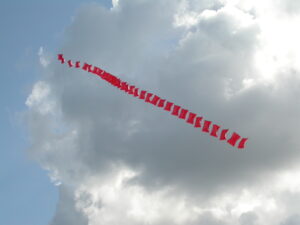 | PDF - A-kross building description | The A-kross is a frame in bamboo for a train of rectangular kites of A3 size. It is unique in that respect that the cells in the train fly steady without a tail. The frame has a 150° dihedral in the leading edge which is flattened out in the trailing edge. | A3 size: 30 x 42 cm.. | 1994 |
2. Fold Black | PDF - Fold Black building description | Inspired by Chinese Rigid Wing kites such as the Swallow, the Fold Black is simply the wing part of the Rigid Wing, only tripled. | Approx. 30 x 40 cm. | 1994 |
3. Salida Sled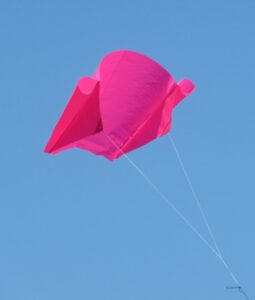 | PDF - Salida Sled building description | Salida Sled (1998, 2002 & 2016) is a pocket kite; a small tail free kite that can always be carried, complete with line and winder, in any pocket or purse. It is made out of one single piece of material (ripstop or plastic) and it needs only two (plus two) seams. One input when designing it was to make it so it did not collapse as frequently as ”standard” sleds do, so that is why the shape is a ”cone”: The idea is that by making the rear end smaller the air pressure inside the skin should build up and keep like a bubble. Another input was to make it tail free. Salida is the name of the opening step/figure when you start dancing tango. | 35 x 28 cm. | 1997 |
4. Sverker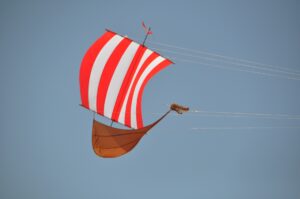 | PDF - Sverker - the Longship kite - building description Full scale bow templates ZIP (JPEG) - Bow for large ship (bow height 150 cm) ZIP (JPEG)- Bow for small ship (bow height 100 cm) | As ‘Sala Drak & Tangosällskap’ (famous group from central Sweden) were going westwards (Washington - Monmouth - Dieppe) in 1996 they decided to make a new Viking invasion, this time from the sky. Karin and Per Byström made the first three ships from flower support bamboo sticks and table cloth from some of the group’s many parties, and called them Svea, Göta and Vendel. | Large: 250 x 200 cm. Small: 165 x 133 cm. | 1996, 2002, 2016 |
5. Eye Phi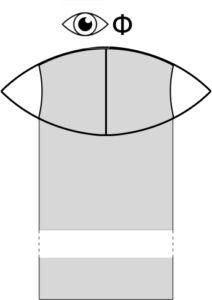 | PDF: Eye Phi building description | Eye Phi is the actual kite part, the lifting part, of the kite YangTze. In the "Documents for downloading" column there is a principle sketch of the Eye Phi frame. | Width 125 - 250 cm | 2016 |
6. YangTze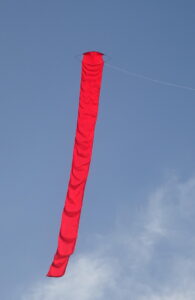 | PDF - YangTze 15m building description PDF - YangTze 30m building description | Bali has the strongest kite culture in the world with several unique kites, one of them is the Janggan which has a tail that usually is 20 times the wingspan. Janggans with wingspans of 3 - 5 m are considered medium size; an 8 m Janggan is large and has thus a 160 m long tail. However, it is not only the length of the tail that is remarkable: it is also the rippling movement of the tail, like waves flowing from the wings down to the end of the tail. A few years ago we, an Australian kite friend visiting Bali and me, talked about how to use the Janggan kind of tail, with the rippling effect, in a western style kite.The idea challenged me: I wanted to make a kite where the lifting part is as invisible as possible (in contrast to the Janggan where the lifting part is very elaborated, especially the head that is richly decorated). It took me half a year before the solution dawned on me: A simple vented wing where the sail continues directly as the tail. The Eye Phi (Eye Φ) frame was born, see no. 5 above. The name YangTze is both a hommage to the origin (Janggan) and a reference to the Chinese river for the riverlike flow of the tail. | Width 125 cm 250 cm Length 15 m 30 m | 2016 |
7. Niëlje | PDF - Niëlje building description Full scale Niëlje templates Full scale plan with grid ready to print out on plotter or on A4 papers and then glued together. ZIP (JPEG) - Niëlje w blue grid.jpeg | Niëlje has a long history. The first attempt, SHARK IV, was made in the late 90's or early 00's but I had severe difficulties to get it flying. Over the years I made modifications, but it wasn't until 2017 that I got it flying. Since I had made SHARK IV unnecessarily complicated I spent a lot of time to make it A) more simple B) more easy to tune In 2019 I felt I was well on the way and gave the kite the name Niëlje, which is South Sami language for 'four'. It is exactly four Skyshark tubes wide and has an aspect ratio of 9.85. | 330 x 33.5 cm | 1997, 2017-2020 |
8. HumbleBee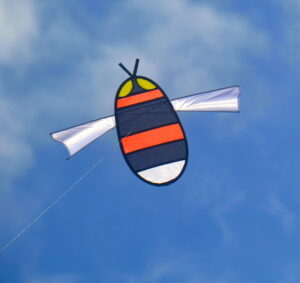 | PDF - HumbleBee building description (Update May 16, 2022) PDF - HumbleBee templates The templates for HumbleBee are split in three A4 pages in horizontal orientation. Two of the pages need to be glued together for the body template (the blue slanted lines in the middle of the body are guide lines for perfect aligning), which should be 36.5 cm high/long when glued together. Make sure the printer prints out the pages correctly. | - The origin of HumbleBee is simply that the name as such popped up in my head. Possibly because the Swedish word for Bumble Bee is Humla. I had the name so just needed to make the kite. Colours are inspired by the Dark Earth Bumble Bee. The HumbleBee has too small wings in relation to the body to be able to fly. But don’t tell her: just wait for a fairly good breeze (4 m/s/) and swing her up in the air. Updated May 22, 2020, with suggestion from Gerhard Wiedra. Updated May 16, 2022, with clarification on template size and outprint of it. | 60 x 44 cm. | 2016, 2020 |
9. Roebuck | PDF - Roebuck building description Zip with templates Roebuck templates Explanation of the different files in the zip can be found in the PDF building description. | Roebuck is a tall ship kite with 4, 3 or 2 sails and optional 'Skull-n-Bones' decoration. The Roebuck is a late development of the viking ship kite Sverker created in 1996. It uses the same technique with bowtie sails that give in-sail dihedrals and a semi 3D bow that works as a wind sock. The development consists simply of adding more sails. The name Roebuck is derived from the name of the ship that was used by the Englishman William Dampier (“Buccaneer, Explorer, Hydrographer and sometime captain of the ship ROEBUCK in the Royal Navy of King William the Third”) when he pirated the seas in South East Asia and Oceania. All tall ships have a lot of tackles and ropes. The corresponding for the Roebuck kite is the bridle system, and to tune the bridle system to find the correct angle of attack, get all bridle parts equally taut and the spine of the kite straight can be somewhat tedious. | 105 x 300 cm | 2018 - 2020 |
10. Nyoman Shimmy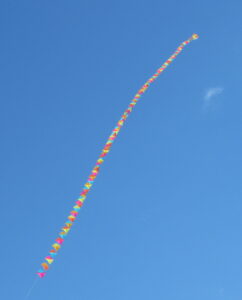  | Building description PDF - Building description for Nyoman - Update 2021-05-14: Clarification at step 32. Templates PDF - Pages which are to be glued together with an overlap of 5 mm. - Nyoman Kecil, 6 pages - Nyoman Besar, 9 pages JPEGs for plotting out in full scale.  - Nyoman Kecil 18" - Nyoman Kecil 18"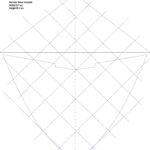 - Nyoman Besar - Nyoman Besar | Single Point, Tail Free and Dancing. The Nyoman [pronounced Nee-oh-man] kite is designed for hassle free trains: The single point allows for easy stacking, and not having any tails reduces considerably the tangling risks. In a train the top kite may have a tail for cosmetic reasons. In-sail dihedral. The Nyoman kite has no dihedral in the cross spar. Instead it has an in-sail dihedral on the rear part of the sail. This is achieved by cutting a wedge out of the front edge of rear sail part. It is this in-sail dihedral that eliminates the need of tail. Shimmying. A third, in the air more visible feature of a train of Nyoman kites, a Nyoman Shimmy, is that the kites are dancing in the air, see video Shimmying. The wind range is 2.5 - 6 ms. The name Nyoman is a hommage to pak Nyoman Adnyana, the Grand Seigneur of Bali kiting. Two sizes. The Nyoman kite can be made in two sizes. The difference in size of sail area is only about 20 %, but the larger one, Nyoman Besar, needs carbon fibre rods for all spars, while the smaller one, Nyoman Kecil, can have either carbon fibre or fibreglass rods. Nyoman Kecil is optimized for those who prefer imperial units: the spars are exactly half a yard (18”). Nyoman Besar is optimized for using 1 meter rods. | 50 x 50 cm. | 2016 |
11. Ronbus 5-3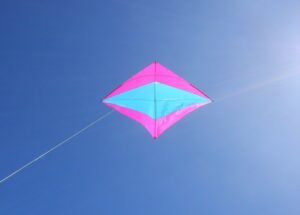 | PDF - Building description for Ronbus 5-3 Full size panel template: ZIP - Ronbus 5-3 templates 194cm.jpeg | The Ronbus 5-3 kite is a single point soaring diamond for very light winds. It is not an original design by me, rather is it a tweak of a tweak: My friend Ron Spaulding is often flying a white high aspect ratio diamond kite when the wind is very light. In 2018 he tweaked it to become single point, but for some reason he was not altogether happy with the result. I asked him then if I could have a go at it. Later it emerged that the original design was by Peter Rieleit already in 2010. Ron’s previous tweaks were to split the sail halves into four panels each and changing the fringe along the trailing edge to wider pieces. My tweak consist mainly of adding a rear in-sail dihedral, two versions of kick-up front and colours. And naming it Ronbus. The 5-3 means it is optimized for 5 + 3 Skyshark tubes. Ronbus 5-3 is a large (3.8 x 2.4 m) light wind kite with a wind range of 1.5 - 3.5 ms. | 380 x 245 cm | 2018, 2021 |
12. FFR - Fat Flat Rok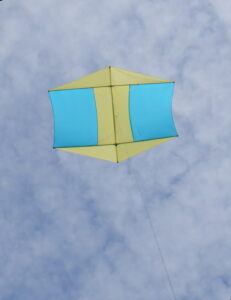 | PDF - Fat Flat Rok Revision 1: 2022-10-10 | The Fat Flat RokThe Fat Flat Rok (FFR) is not a traditional rokkaku. Fat - A traditional rokkaku has as an aspect ratio less than 1 (i.e. it is taller than wide). The FFR has an even or slightly high aspect ratio, making it look ‘fat’. Flat - A traditional rokkaku has backward bent cross spars. The FFR has straight cross spars. If a person doesn’t say “Well, how can that be?” you know this person is not a real kite maker. Rok - Rokkaku just means ‘6 cornered’ after all. The answer to the “flat?” question is the shape of the middle sail part: it has the shape of a bowtie, which creates an in-sail dihedral by the wind, enough to make the kite stable. However, the FFR is not suitable for rokkaku combats: the bridle can not be changed to make the kite steerable. This brief description is not a plan for a specific kite; rather is it a description of the FFR concept, and it only shows how to cut the different panels. For reinforcements and pockets for spars as well as for reinforcements for bridle, building descriptions for a standard Rokkaku and a standard Sode Dako should be consulted. The description include plans for FFRs in different sizes and with different aspect ratios. Two of the plans are provided by Ron Spaulding. | Variabel | 2005 |
13.Thor Nado | PDF - Building description for Thor Nado Full scale Thor Nado templates --Thor Nado VFFR - template --Thor Nado tail 1 - template --Thor Nado tail 2 - template --Thor Nado tail 3 - template ZIP with the templates: Thor Nado templates Corrected 2021-09-09: Thor Nado tail 3 - template. | The Thor Nado Thor Nado is a high wind kite which basically is a VFFR - Very Fat Flat Rok (See #12 above) - with a long tapered tube tail that starts inside the VFFR as a tunnel keel. The width of the VFFR is 1.5 m and the length of the tail is 28 - 30 m. The purpose of the design was to make a high wind kite where the tail is an integral and prominent part of the complete kite. The VFFR as such flies well without any tail, but the tapered tube tail adds a great presence in the sky. See youtube video: Thor Nado Wind range 3 - ? ms (So far flown up to 7 ms but should be able to stand a lot more. Maybe the 8 mm carbon tubes need to be replaced with 10 mm carbon tubes for really high winds). | 1.5 x 30 including tail | 1997, 2006, 2017, 2021 |
14. WannaBee | PDF - WannaBee Building description Templates PDF - Template set - A3 PDF - Template set - A4 JPEG - 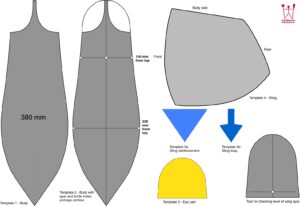 | WannaBees - a bee swarm. The WannaBees are inspired by Nest Lernout’s kite Bee Nest. I saw the Bee Nest already at a kite festival in Washington/Sunderland in 1996 and liked it very much, but thought there was something fundamentally wrong with each bee: It had a pointed head and a round bottom whereas a real bee has a round top and the bottom, where the sting is, is the end that is pointed. I quickly made a clever design that only needed two sticks: one shorter for the body and one longer for the wings. However, it took till 2009 till I found material to actually make it: a single 200 cm piece of fibreglass rod cut into two parts was perfect for one bee: 78 cm for the body and 122 cm for the wings. See video for WannaBee swarms in flight: https://youtu.be/WxUWSQNZdDI | 40 x 40 cm | 2009, 2012, 2021 |
15. akka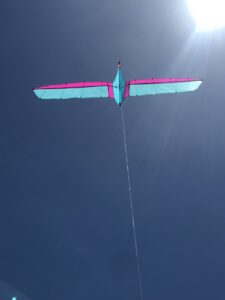 | PDF - akka building description ZIP file akka templates and STL | akka akka is a self correcting high aspect ratio single point kite which has taken a long time to develope, mainly because of construction obstacles: how to attach the wings to the body and how to get the wing battens fanning out. A few years ago Henrik Fristrup Jensen showed me one of his high aspect ratio kites and I immediately saw I could use his solution: a single continuous skin with integral body. Then Roman Skrzek helped me with the other awkward problem: making 3D connectors for the various batten angles required for the self correcting function. The kite is named ’akka’ after the leader goose in Selma Lagerlöf’s ”Nils Holgersson’s Wonderful Journey Through Sweden”. The kite might look fairly simple, but it requires a for me unusual level of accuracy to build. The building plan includes the building manual, two sets of templates: one for plotting out in full scale in one piece and one for printing out on A4 sheets and gluing them together (these sheets have criss-cross guide lines to facilitate the alignment between pages) and an STL file for 3D printing out the batten connectors. The templates and the STL files are in a ZIP file. | 250 x 65 cm | 2017 - 2022 |
16. Abok #2287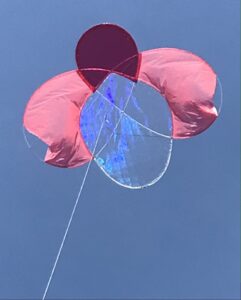 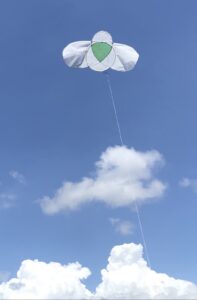 | PDF - Abok #2287 Building description ZIP - PDF with templates for wing sails in A3 size. Abok #2287 wing sail templates | Abok #2287 In the Ashley Book of Knots the knot #2287 is a “four-bight Turk’s Head knot, in disk form” without any special name. The knot can be used as frame of a small kite. The bights lengthways then have a plain skin while the bights across have vented wings, what the Japanese call fu-tai wing (kanji 風袋), that create an in-sail dihedral. This plan describes three different shapes (A, B and C) of the #2287 knot, as well as three different sizes for the shapes A and B. A. Regular knot. B. Insect. C. Gnat. Since the Abok #2287 [Ashley Book of Knots] is not an original Windman-Biegolmai invention, only various applications of an existing frame, this description is not a regular step-by-step plan but leaves much to own experiments. Abok #2287 is essentially a low wind kite and can fly at a quite steep angle also in low wind. | Various sizes from 39 x 23 cm to 68 x 68 cm | 2022 |
17. Pretzzl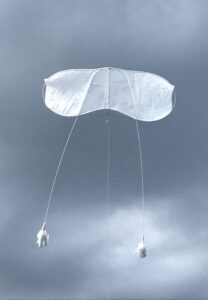 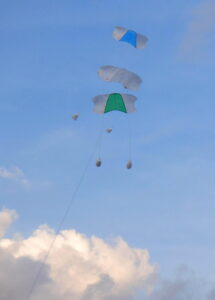 | PDF - Pretzzl building description PDF - Print out in A3 size. Pretzzl skin A3 | Pretzzl Pretzzl is a single rod kite, where the rod is bent in two bights to create the wing shape. The wings sails are vented, what the Japanese call fu-tai wing (kanji 風袋), that create an in-sail dihedral. The kite has two long balance sprouts with tassels at the end. It uses two tensioning strings (shape shifting strings) to create the shape of the body. However, this is not a knot kite since the rod is not weaved over-and-under itself. Pretzzl can be stacked to at least a short train, although multiple kites probably might look better as a flock on separate strings. The name Pretzzl is of course derived from the pastry. | Width 57 cm and 38 cm | 2022 |
18. Rondevoo 5-2 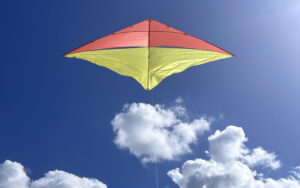 | PDF - Building description Rondevoo 5-2 ZIP - Full scale (206.5x184.2 cm) templates, four panels. Templates Rondevoo 5-2.jpeg | Rondevoo 5-2 Rondevoo 5-2 is an ultra light wind kite made as an homage to my good friend Ron Arztmann. In 2020 Ron gave me two pieces of light weight ripstop: Bainbridge AirX 500N at 30 grams/meter and AirX 400N at 26 grams/meter. At that time I didn’t have any suitable project in the pipeline, and after he passed away I thought I needed to create something very special, so I just kept waiting for an idea. The name Rondevoo came first and after that the idea of an ultra low wind kite with dual leading edge. The design is basically like an Indonesian/Indian fighter kite, built with experiences from the Ronbus 5-3 kite, but with a higher aspect ratio: 2.4, and with vented front sail. Featured design details: • DLE - Dual Leading Edge - the front panels are vented in the bottom. • KUF - Soft Kick Up Front - the front half of the spine is bent upwards. • ISD - In-Sail Dihedral - the rear panels have extended trailing edges. • HAR - High Aspect Ratio - 2.4. • SP - Single Point - three separate tow points for ultra low wind, low wind and medium breeze. Rondevoo 5-2 is intended to be built in very light materials, such as Bainbridge AirX 500N/400N, Icarex PC31 or Skytex 27 and with a frame of Skyshark tubes, such as P90 (5 Skyshark pieces for the bent cross spar and 2 Skyshark pieces for the spine, hence 5-2 in the name). | 402 x 166 cm | 2023-2024 |
19. Acrux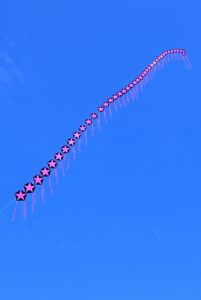 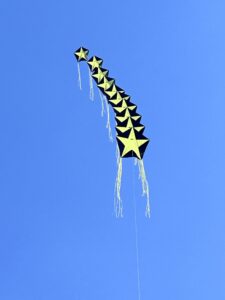 | PDF - Building description for Acrux ZIP - Templates for Acrux and STL files for 3D printing of dihedral. Acrux Template and STL files | Acrux Acrux is a pentagram/pentagon kite primarily intended for kite trains, although each kite element can also fly by itself. A single tail free Acrux element flies stable on its own, but when trained, sometimes elements flip to upside down and don’t recover easily. For that reason it is recommended to add a double tail. Here the tails are split in five narrow strips, representing the five points of the pentagram. The train element is 40 cm high in this description just to fit the size of a kite bag, but it can also be upsized to at least 70 cm. The name Acrux is derived from the most prominent star in the star constellation Southern Cross. The WomBag plan mentioned in the last page will be published in November. | 40 x 40 cm | 2024 |
20. WomBag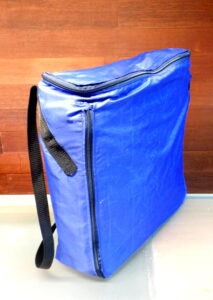 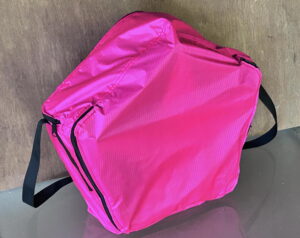 Video on how to use WomBag. 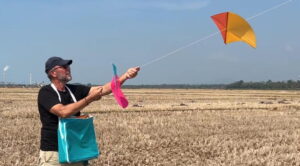 | PDF - Building description of WomBag ZIP - Acrux 40 cm WomBag.jpeg | WomBag WomBag is not a kite, just a bag that makes launching a kite train, like the Nyoman Shimmy or the Acrux train, more secure and less prone to hassle. - The train elements are secured in a size optimized container. - The body of the kite flier protects the train stack from sudden wind gusts. - The kite flier is fully mobile and can move around while launching to avoid sudden obstacles on the kite field or in the sky. For launching the kite flier wears the bag on the chest (or the belly) with a strap around the neck, leaving both hands free. The bag has two openings: One on the short end (top) of the bag for launching and one on the flat side (front) of the bag for packing/stuffing the kites. When packing the bag after flight it is horizontal on the ground, with the opened lid on the ground behind the bag. | Depending on train element size. | 2022 - 2024 |


Thank you Andreas. I found the plan for the Salida sled already elswhere before and used it, I intend to used more of your Creations.
I have admired your work for years, and enjoyed our online discussions!
Hola Andrea admiro tu trabajo creaciones !! Fantástico!! El abrazote de siempre
¡Gracias Roberto! ¡Extraño volar barriletes con Batoco en Vicente López!
Thanks for this link. Any way I can get the plans for the following years 2018, 1996 and 2002. Thanks.
Not sure what you mean with ‘plans for 2018, 1996 and 2002’? Which kites?
Thank you very interesting kites ! I have been designing a new train same size no dihedral ,still working on the design. Looking at A Kross , love the no tail, thanks for the inspiration!
The A Kross does have a dihedral, but the Nyoman not. Need some more testing though before the plan for Nyoman train can be published.
Andreas me encanta el Eye Phi, para un ancho de tela de 150cm que largo de cola tengo que calcular?
y la medida de las bridas?
Muchas gracias desde Argentina, BaToCo!
Pablo, generally for lenght I use 20 times the width of the cloth, so with 1.5 m width the length is about 30 m. The bridle string is about 6 m.
Thanks a lot for the YangTze Plan. ♥♥♥
Thank you for proofing!
All kite desine is beautiful